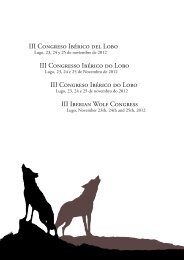Bison-Rewilding-Plan-2014
Bison-Rewilding-Plan-2014
Bison-Rewilding-Plan-2014
- No tags were found...
You also want an ePaper? Increase the reach of your titles
YUMPU automatically turns print PDFs into web optimized ePapers that Google loves.
2.3Current conservation statusRecent globalpopulation estimatesfor free-ranging(un-fenced) Europeanbison (<strong>Bison</strong> bonasus)2.3.1 Global conservation assessmentThe IUCN Red List of Threatened Species currentlylists the European bison as Vulnerable. In additionto this, it distinguishes between the two geneticlines: the Lowland line (B. b. bonasus) and theLowland-Caucasian line (B. b. bonasus and B. b.caucasicus). The Lowland bison line is consideredVulnerable based on data from 2000, when thetotal population was 931 individuals. Although thepopulation declined between the early 1990s and2000, it is currently increasing. The Lowland-Caucasianline is considered Endangered based ondata from 2000, when the total population was714 individuals. The population decreased by 20%between 1990 and 2000, and has continued todecline since 2000.A population estimate from 2011, withadditional information from 2013, put thepopulation of free-ranging European bison at2,371 individuals. At the country level, strongholdsfor the species exist in Poland (36%), Belarus(34%) and Russia (17%), with smaller populationsin Ukraine (9%), Lithuania (2%), Romania (< 1%),Germany (< 1%), Slovakia (< 1%) and Latvia (< 1%)(Table 1).The current pedigree book (EBPB 2012) reportsthe global population of European bison as 4,987individuals. However, data on European bisonpopulations as of 31 December 2012 were publishedin <strong>2014</strong> and in accordance with data obtainedfrom personal communication with breeders thisnumber now stands at 5,046, with the numberof individuals living in captivity at 1,643 and thenumber of individuals from free and semi-freeherds at 3,403 (Magda Trzeciak, personal communication,<strong>2014</strong>).EstimatedpopulationYearassessedReferenceGlobal/Europe 3,230 2013 EBPB 2012; EBCC 2013, <strong>2014</strong>Belarus (Lowland) 1,146 2013 EBPB 2012; EBCC 2013Germany (Lowland-Caucasian) 10 2013 Van de Vlasakker 2013Latvia (Lowland) 12 2013 EBPB 2012Lithuania (Lowland) 82 2013 EBPB 2012; EBCC 2013Poland (Lowland Caucasianin Bieszczady)1,138 <strong>2014</strong> EBPB <strong>2014</strong>; EBCC <strong>2014</strong>Romania (Lowland-Caucasian) 21 2013 Deju 2013; EBPB 2012Russia (Lowland-Caucasian) 556 2013 EBPB 2012; EBCC 2013Slovakia (Lowland-Caucasian) 15 2013 EBPB 2012; EBCC 2013Ukraine (Lowland-Caucasian) 250 2013 EBPB 2012; EBCC 20132.3.2 Current threats to EuropeanbisonInsufficient habitatEuropean bison continue to lack the space requiredfor viable populations. Most conservation effortsare still focussing outside the species’ optimumrange and are mainly concentrated in forestedand mountainous habitats (see section 3.2). This islargely because across Europe, suitable habitat forEuropean bison generally coincides with regionsthat support high human populations, e.g. rivervalleys and lowland areas with productive soils.Small population sizeSmall population size is also a major threat to thelong-term viability of European bison populations.Most contain fewer than 50 individuals, despite thefact that the minimum viable population size hasbeen estimated at 1,000 individuals (Perzanowskiet al. 2004; Pucek et al. 2004). The species has lowgenetic diversity due to all modern populationsbeing descended from only 12 founder individuals(Olech and Perzanowski 2002; Pucek et al. 2004) andthe genetic contribution of the 12 founders is alsouneven, highly dominated by one pair. The mixingof both Lowland and Lowland-Caucasian lines ofEuropean bison has also locally led to the loss offounder genes specific to the Lowland-Caucasianline.DiseaseThe limited genetic heterogeneity, low numbers andlack of natural selection might all have contributedto the species’ weak resistance to diseases (Pucek2004, van de Vlasakker 2008). An important disease,balanoposthitis, affects the male reproductiveorgans and is manifested in the inflammation ofthe penis and prepuce. Despite years of study, itspathogenesis has not yet been clarified (Pucek et al.2004). Parasitic diseases remain a serious threat tothe present population. <strong>Bison</strong> that receive supplementaryfeeding show higher parasite infestationdue to concentration of bison and subsequentdefecation at fixed feeding locations, combinedwith more sedentary behaviour encouraged bysupplementary feeding (Radwan et al. 2010; Pyziel etal. 2011). Viral (foot and mouth disease) and bacterialdiseases (tuberculosis) can also be transferred fromdomestic cattle to bison, and it is these diseaseswhich are the most dangerous for the bison. Lownumbers of bison in combination with additionalstress factors such as climate change are also18



